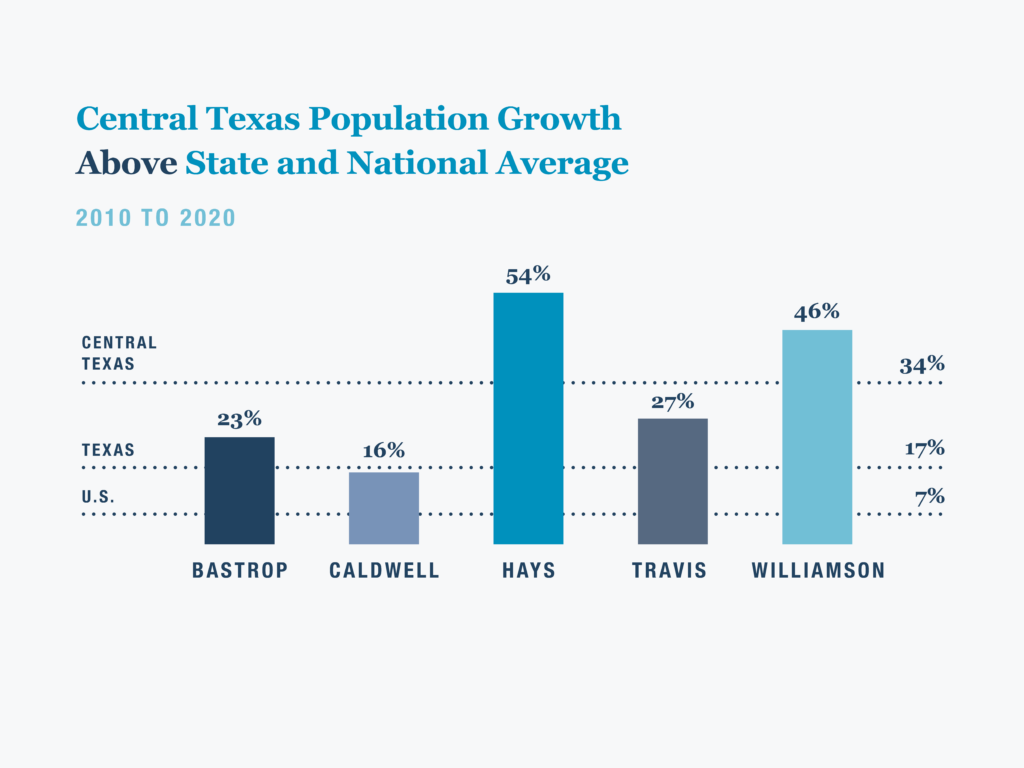Takeaway
The Issue
Hays County is one of the fastest growing counties in the U.S. While rapidly growing and becoming more diverse, it has also become less affordable. These changes are affecting health outcomes for underserved community members due to a person’s health being largely determined outside of the clinic setting through non-medical drivers of health such as safe, affordable housing, access to healthy foods and transportation. In addition, the growth is impacting access to care as provider availability is limited for underserved populations who experience adverse health outcomes and face significant barriers to health care.
In one decade (2010-2020), Hays County’s population grew 53%, far exceeding the average population growth among Central Texas counties, and Hispanic/Latinx residents accounted for 45% of the total population growth during this time. Approximately, 10% of Hays County residents were born in a country other than the U.S. and 64% of these are non-citizens, increasing the need for culturally and linguistically competent care to meet the needs of all residents.
At the same time, housing costs skyrocketed. In fact, in one year (2020 to 2021), the median house price increased 27.9%, perpetuating the financial insecurity of residents and creating an undue burden on residents, who on average, spend 27% of their monthly income on housing and 15.7% spend more than 50% of their monthly income on housing. This makes other basic needs like food, transportation, and health care cost prohibitive.

From 2015-2019, 13.7% of residents lived below the federal poverty level and an additional 30% of households were asset limited and income constrained – despite being employed.
On top of the stressors stemming from costs of living increases and reported job losses in the area, the COVID-19 pandemic further challenged the financial stability of lower-income residents, negatively impacting mental health and creating greater food insecurity. Lack of public transportation limits access to jobs, health care, and food. Hays County focus group participants noted that transportation options were limited and further inhibited access to health care and food for low-income residents.
In the qualitative analysis community members and leaders identified several priority health issues including depression and anxiety, diabetes, hypertension, obesity, and cancer as well as binge drinking among young adults as priority health concerns.
Historically underserved residents face several barriers when trying to manage and treat these health concerns. Due to the cost of care, 17% of adults reported delaying needed health services in 2017. In the county, 16.7% residents under the age of 65 are uninsured and there are limited options for low- or no-cost care. Dental care was also cost prohibitive. Additionally, the county has been designated a primary health professional shortage area for primary and mental health.
Looking forward: Hays County has several community assets and strengths, including a strong sense of community. Individuals, local nonprofit organizations, school districts, and churches of various denominations are well-networked and coordinate with each other to provide food and social services. It is home to six hospitals and several clinics that serve low-income residents. Hays County also offers a lot of natural space, and in the Buda and Kyle ZIP code tabulation area, over half of the residents live within a 10-minute walk of a park.
The Findings
Community members provided several recommendations to address health-related needs for the community. The recommendations fell in three priority areas: Building Trust, Increasing Affordability and Access, and Reducing Barriers.
Build trust between the health care system and the community by requiring a culturally competent workforce, establishing partnerships with trusted organizations (schools, churches, nonprofits), engaging and reaching out to community-based organizations to distribute information about health fairs or other hospital events and services (such as vaccine clinics), enhancing language and translations services by ensuring all materials are linguistically accessible, increasing the number of Spanish-speaking providers or providers with translation services, including language on office and hospital marketing materials that explicitly welcome historically excluded populations, and removing requirements for photo IDs or proof of citizenship.
Increase affordability and access by expanding low-cost or free clinics, providing sliding scale payment options or co-pay assistances for preventative care, removing barriers for nonprofits to pay for services on behalf of clients, building awareness of free or low-cost services, offering mobile clinics with free or reduced cost services, expanding access to providers (pediatricians, OB/GYN, endocrinologist, ophthalmologists, and cardiologists), and improving and expanding access to affordable, culturally sensitive, and accessible mental health services for adults and minority community members.
Reduce barriers in the community with affordable, free, and culturally appropriate prevention-focused classes or lifestyle change programs by collaborating with community-based organizations to host classes and programs that address diabetes and hypertension; improving local transportation options by expanding CARTS or establishing privately funded buses or vans to connect clinics and communities; and expand access to affordable and healthy food.
Download the report below to learn more about the 2022 community health needs assessment findings for Hays County.